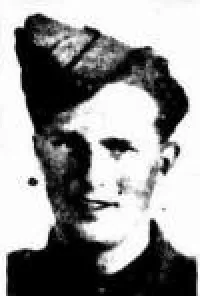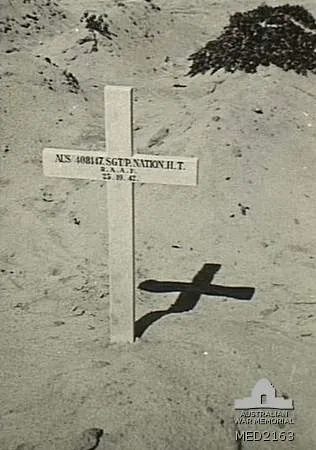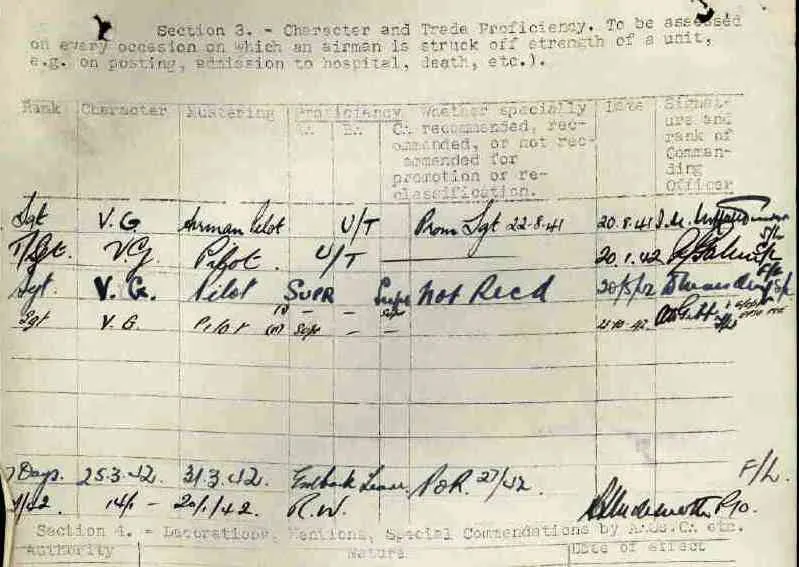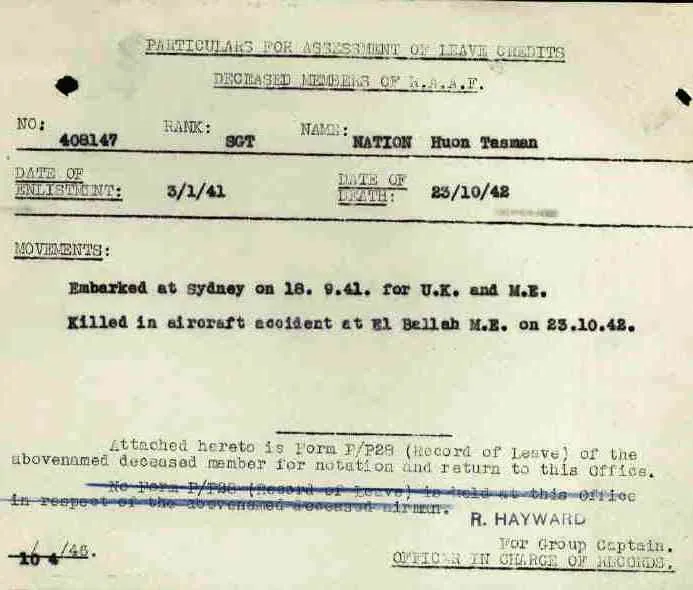SGT Huon Tasman Nation 408147



| Squadron/s | 1 METS RAF |
| Rank On Discharge/Death | Sergeant (SGT) |
| Mustering / Specialisation | Pilot |
| Date of Birth | 20 Feb 1916 |
| Date of Enlistment | 03 Jan 1941 |
| Date of Death | 23 Oct 1942 |
| Contributing Author/s | Phil Listermann, David Hamilton Updated Vince Conant, 2013 The Spitfire Association |
Huon was born on the 20th February 1916 at Scottsdale in Tasmania. We had to check that we indeed had the correct name for this fellow and yes, it is correct. We can safely assume Mum and Dad were proud Tasmanians.
He enlisted on the 3/1/1941 and was posted to No 1 Middle East Training Squadron. Just a short year or so later he died 23rd October 1942.
Service number: 408147
Rank: Sergeant
Unit: 1 Middle East Training School RAF
Service: Royal Australian Air Force
Conflict: 1939-1945
Date of death: 23 October 1942
Place of death: Middle East
Cause of death: Accidental
Cemetery or memorial details: Moascar War Cemetery, Egypt
Source: AWM148 Roll of Honour cards, 1939-1945 War, Air Force
KILLED IN ACTION
Pte. Donald Nation, A.I.F., third son of Mr. and Mrs. L. Nation New Town, who has been killed in action. He was previously reported "missing, believed killed."
WAR CASUALTIES Mr and Mrs Arthur Nation, Scottdale, have received word from the Air Board that their youngest son, Sergeant-Pilot Huon Tasman Nation R.A.A.F., lost his life as the result of an air accident in the Middle East. He was 25 years of age, and joined the R.A.A.F. two years ago. In September last year he was drafted to England and later transferred to the R.A.F. with which he was serving at the time of the accident. Sergeant Pilot Nation leaves a wife and two children, who reside at Stanley.
What was the Empire Air Training Scheme?
At the outbreak of the Second World War the British government realised it did not have adequate resources to maintain the Royal Air Force (RAF) in the impending air war in Europe. While British factories could rapidly increase their aircraft production, there was no guaranteed supply of trained aircrew. Pre-war plans had identified a need for 50,000 aircrew annually, but Britain could only supply 22,000.
To overcome this problem, the British government put forward a plan to its dominions to jointly establish a pool of trained aircrew who could then serve with the RAF. In Australia the proposal was accepted by the War Cabinet and a contingent was sent to a conference in Ottawa, in Canada, to discuss the proposal. After several weeks of negotiations, an agreement was signed on 17 December 1939 which would last for three years. The scheme was known in Australia as the Empire Air Training Scheme (EATS).
Under the scheme 50,000 aircrew would be trained annually, each dominion would conduct its own elementary training; advanced training would be conducted in Canada because of its closeness to the British aircraft factories and the war zone. From November 1940, some training was also conducted in Rhodesia (now Zimbabwe).
Australia undertook to provide 28,000 aircrew over three years, which represented 36% of the total number of proposed aircrew. The first basic flying course started on 29 April 1940, when training began simultaneously in all participating countries. The first Australian contingent embarked for Canada on 14 November 1940. The following Royal Australian Air Force (RAAF) schools were established across Australia to support EATS:
• Initial Training
• Elementary Flying Training
• Service Flying Training
• Air Navigation
• Air Observer
• Bombing and Gunnery
• Wireless Air Gunnery
Under Article XV of the agreement, it was proposed that each country’s aircrew would serve in distinct national squadrons once they arrived in Britain. Eventually there were 17 Article XV RAAF squadrons, these being numbered 450–467 (but with no 465 formed). Four of these units were in Fighter Command, seven in Bomber Command, and one in Coastal Command. Another five were also formed in the Middle East. However, despite Article XV, the bulk of Australian aircrew served with RAF squadrons and not with a designated Australian squadron.
The agreement was renewed for an additional two years in March 1943, although by then it was evident that the RAF already had a large surplus of aircrew. Throughout 1944 Australia’s contribution to the scheme was wound back, at Britain’s instigation, and the scheme effectively ended in October 1944, although it was not formally suspended until 31 March 1945. By this time, over 37,000 Australian airmen had been trained as part of the scheme. [AWM]
Dedicated to Huon’s children Patricia Kathleen and Barry Nation


